Are you looking to learn more about horse fencing? Well, you’ve come to the right place! Horse fencing is an important aspect of horse care and there is so much to know about it. In this article, we’ll dive into the world of horse fencing and discuss everything from different types of fences to installation and maintenance. By the end of this article, you’ll be equipped with valuable knowledge about horse fencing that will help you make informed decisions for your horses’ safety and well-being.
When it comes to horse fencing, there are numerous options available. We’ll explore the pros and cons of each type, including wooden fences, electric fences, mesh fences, and more. We’ll also discuss the importance of proper installation to ensure the fence is sturdy and secure. Maintaining horse fences is crucial for their effectiveness, as horses can be quite rough on fences. You’ll learn about routine inspections, repairs, and preventive measures to extend the lifespan of your horse fence. Whether you’re a first-time horse owner or a seasoned equestrian, this article will provide you with valuable insights into horse fencing. So, let’s get started and learn all there is to know about horse fencing!
All About Horse Fencing
Horse fencing is an essential aspect of owning and managing horses. It not only serves as a means of containment but also ensures the safety and security of these majestic animals. Choosing the right type of horse fencing requires careful consideration of various factors, including safety, durability, maintenance, cost, and visibility. In this article, we will explore the different types of horse fencing, factors to consider when choosing horse fencing, installation tips, maintenance and repairs, regulations, design considerations, and much more.
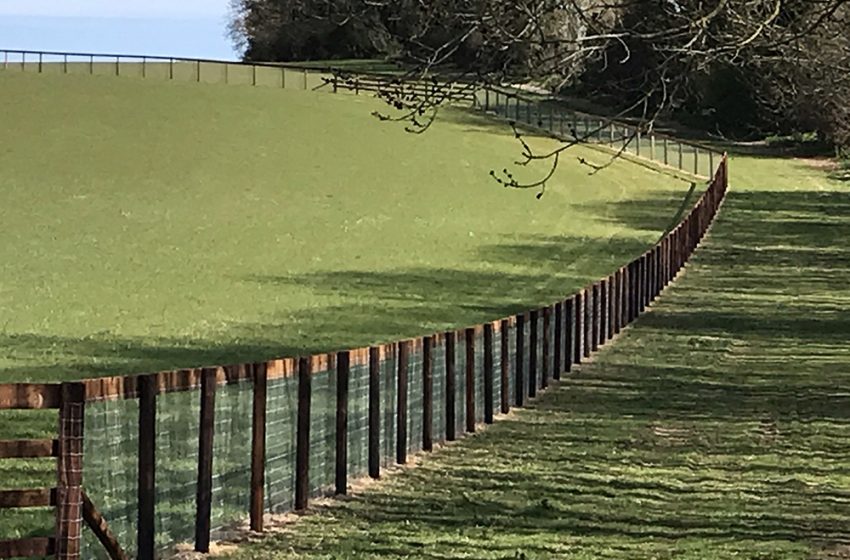
Types of Horse Fencing
Wooden Fencing
Wooden fencing is a classic and popular choice for horse owners. It provides a traditional and aesthetically pleasing look while offering durability and strength. However, wooden fencing requires regular maintenance, including staining or painting, to ensure its longevity. We will discuss more about maintenance later in this article.
Vinyl Fencing
Vinyl fencing is a low-maintenance alternative to traditional wooden fencing. It is highly durable, does not rot or splinter, and is resistant to weather elements. Vinyl fencing also offers a wide range of customization options, including different colors and styles. Although it may be more expensive initially, its long-term durability and minimal maintenance make it a popular choice for horse owners.
Electric Fencing
Electric fencing, also known as electric tape or wire, is a cost-effective option for horse owners. It consists of electrified strands that provide a minor shock to the horse upon contact. Electric fencing is effective for containing horses but requires proper training to ensure they respect the boundaries. We will discuss more about training horses to respect fencing later in the article.
Woven Wire Fencing
Woven wire fencing is another widely used option for horse enclosures. It consists of tightly woven wire mesh that provides high visibility and durability. Woven wire fencing is effective in preventing horses from escaping and keeping predators out. However, it requires proper installation and regular maintenance to avoid any potential injuries.
Pipe Fencing
Pipe fencing, made of steel or aluminum pipes, is a sturdy and long-lasting option for horse enclosures. It offers excellent visibility and requires minimal maintenance. Pipe fencing is commonly used for large equestrian facilities or high-traffic areas. However, it can be costly and may not be suitable for all budgets.
Factors to Consider When Choosing Horse Fencing
When selecting horse fencing, several factors should be taken into consideration:
Safety
The safety of horses should be the top priority when choosing horse fencing. The fencing material should be sturdy enough to prevent injuries from protruding nails, sharp edges, or loose wires. It should also be designed to minimize the risk of entanglement, especially for young and curious horses.
Durability
Horse fencing should be able to withstand the demands and challenges of outdoor environments. It should be able to withstand extreme weather conditions, such as strong winds, heavy rain, or snow. Additionally, it should be resistant to rot, decay, and insect damage.
Maintenance
Consider the level of maintenance required for different types of horse fencing. Some materials, such as wood, may require regular staining or painting to maintain their appearance and durability. On the other hand, vinyl or electric fencing may require minimal maintenance.
Cost
Budget constraints often play a significant role in selecting horse fencing. The cost of materials, installation, and long-term maintenance should be taken into account. It is essential to choose a fencing option that fits within your budget without compromising safety and durability.
Visibility
Horses rely on their vision to navigate their surroundings and detect potential threats. Therefore, the visibility of the fencing material is crucial. Opt for fencing that allows horses to see beyond their enclosure, reducing the risk of accidents and anxiety.
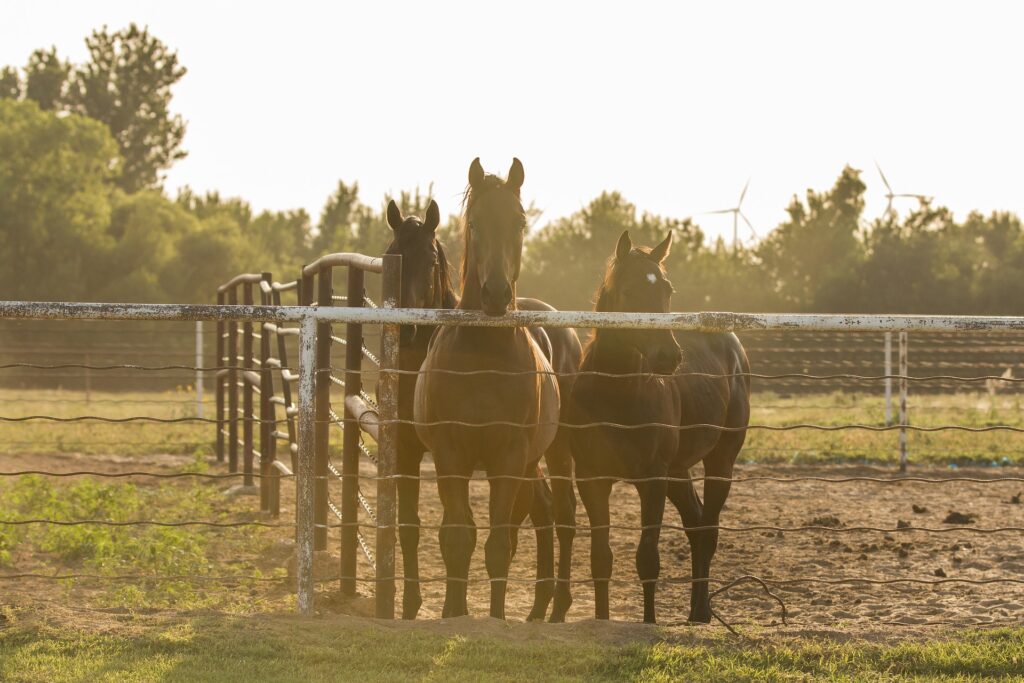
Installing Horse Fencing
Ensuring proper installation of horse fencing is vital to its effectiveness and longevity. Follow these steps for a successful installation:
Preparation
Prepare the area where the fencing will be installed. Clear any debris, rocks, or vegetation that may interfere with the installation process.
Tools and Materials Needed
Gather the necessary tools and materials for the installation process. This may include posthole diggers, a level, a measuring tape, fence panels, posts, and appropriate fasteners.
Measuring and Marking
Measure the perimeter of the area where the fence will be installed. Mark the desired position of the fence posts and gates using stakes or spray paint.
Setting Posts
Dig holes for the fence posts, ensuring they are deep enough for stability. Insert the posts into the holes and secure them with concrete or gravel. Allow the posts to set before proceeding to the next steps.
Attaching Fence Panels
Attach the fence panels to the posts using appropriate fasteners. Ensure that the panels are level and securely attached to provide maximum strength and security.
Proper Maintenance and Repairs for Horse Fencing
Regular maintenance and timely repairs are essential to keep horse fencing in optimal condition. Here are some maintenance tasks and repairs to consider:
Regular Inspections
Regularly inspect the entire fence line to identify any loose boards, damaged panels, or other potential issues. Inspections should be conducted at least once a month.
Fixing Loose or Broken Boards
Secure loose boards or replace broken boards promptly. Loose or broken boards can create hazards for horses and compromise the effectiveness of the fence.
Replacing Damaged Panels
If any fencing panels are damaged beyond repair, replace them promptly. Damaged panels can weaken the overall structure of the fence and compromise safety.
Painting and Staining
Wooden fencing may require painting or staining every few years to protect it from the elements. Follow manufacturer recommendations for appropriate paint or stain products.
Cleaning and Removing Debris
Regularly clean the fence line by removing dirt, debris, and vegetation. This not only improves the appearance but also prevents the accumulation of moisture that can lead to decay or rust.
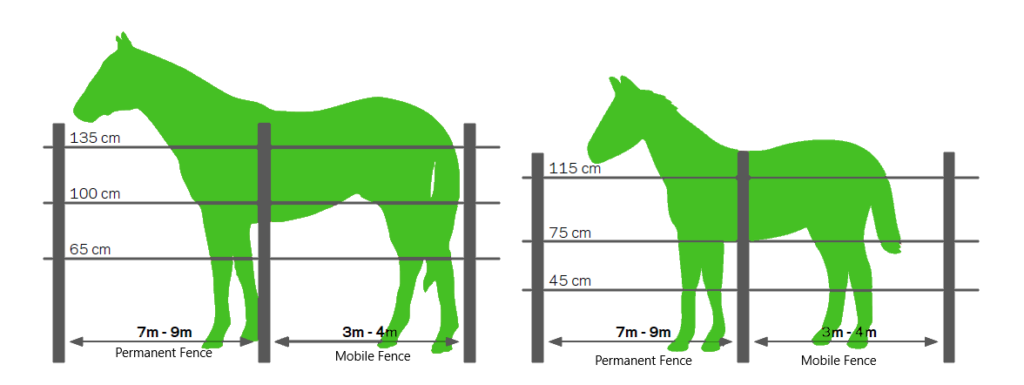
Horse Fencing Height Regulations
Horse fencing height regulations may vary depending on local and state guidelines. It is essential to research and comply with the specific regulations in your area. Here are some general considerations regarding fencing height:
Local and State Regulations
Contact your local governing authority or horse associations to determine any specific regulations regarding horse fencing height. Regulations may vary based on the type of property, proximity to public roads, and density of horse populations.
Recommended Heights for Different Breeds
Consider the different sizes and athleticism of various horse breeds when determining fence height. Higher fencing may be required for larger and more spirited breeds to prevent jumping or escape.
Jumping and Escape Prevention
Ensure that the fencing height is adequate to prevent horses from jumping over or escaping. This is particularly important for fencing located near roads, wooded areas, or properties with other livestock or predators.
Designing a Safe and Functional Horse Fence Layout
Proper design and layout of horse fencing can enhance safety, functionality, and efficiency. Consider the following aspects when designing your horse fence layout:
Creating Secure Enclosures
Divide the property into secure enclosures that allow for easy movement of horses while minimizing the risk of accidents, injuries, or escapes. Plan the layout based on the number of horses, their individual needs, and pasture rotation requirements.
Gates and Entryways
Strategically place gates and entryways to allow convenient access for horses, vehicles, and equipment. Ensuring ease of movement within the enclosure reduces stress on horses and facilitates daily management tasks.
Dividing Pastures
Consider dividing pastures into smaller sections to allow for rotational grazing. This can help maintain pasture health and prevent overgrazing in certain areas.
Separating Stallions and Mares
If housing stallions and mares on the same property, consider separate enclosures to prevent unwanted breeding. Installing a secondary fence and managing the distance between enclosures is crucial for safety and breeding control.
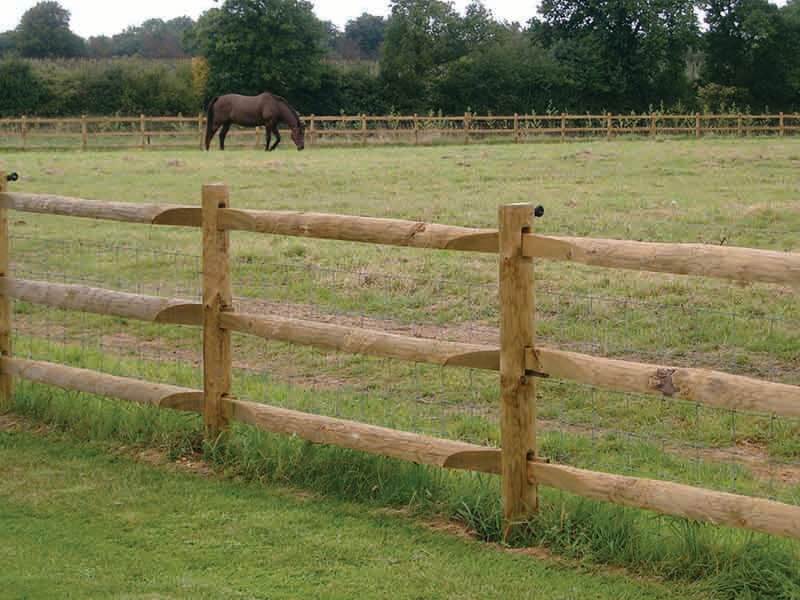
Common Issues and Challenges with Horse Fencing
Despite careful planning and maintenance, horse fencing can encounter various challenges and issues. Here are some common ones to be aware of:
Horse Escape Strategies
Horses are incredibly resourceful when it comes to finding possible escape routes. They may push or test fences, dig under them, or even jump over them. Regularly inspect the fence line for any signs of attempted escapes and reinforce weak areas promptly.
Damage from Weather and Wildlife
Harsh weather conditions, such as storms or extreme heat, can cause damage to horse fencing. Additionally, wildlife, such as deer or small animals, may cause damage by burrowing or chewing on the fencing. Regular inspections and prompt repairs are essential to prevent further damage.
Invasive Plants and Fence Line Clearing
Overgrown vegetation, including invasive plants, can put pressure on horse fencing. Clearing the fence line regularly and controlling vegetation growth is important to maintain the integrity of the fence and prevent potential damage.
Neighborhood Relations and Boundary Disputes
Fencing disputes with neighboring properties can arise, especially if horses are kept near property boundaries. Establishing clear property lines and open communication with neighbors can help prevent conflicts and facilitate solutions if any issues arise.
Landscaping and Aesthetics with Horse Fencing
Horse fencing can serve both functional and aesthetic purposes. Consider the following aspects when landscaping and designing your horse fence:
Choosing Fencing Materials that Complement the Surroundings
Select fencing materials that blend harmoniously with the surrounding landscape. This can enhance the overall appearance of the property and create a cohesive aesthetic.
Adding Privacy or Decorative Elements
Depending on your preferences and needs, you may choose to add privacy elements, such as shrubs or trees, along the fence line. Decorative elements like flower beds or ornamental gates can also enhance the overall look of the fencing.
Incorporating Gates and Walkways
Strategically placed gates and walkways can improve accessibility and functionality. Consider the flow of daily activities and movement of horses when designing gate and walkway locations.
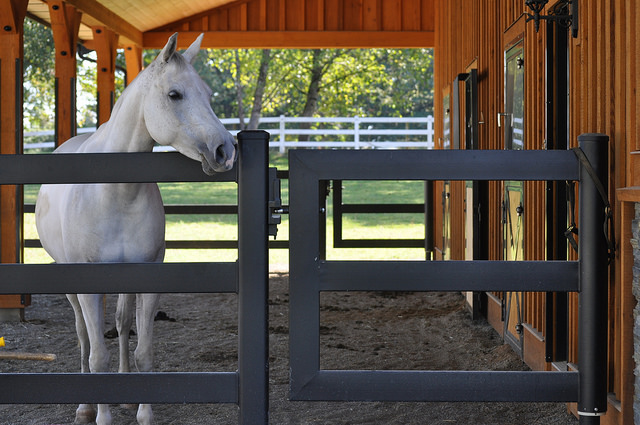
Horse Fencing Accessories and Additional Features
In addition to the fencing itself, several accessories and additional features can enhance the functionality and safety of horse fencing. Consider the following options:
Electric Fence Chargers
Electric fence chargers, also known as energizers, provide power to electric fencing systems. Choose a charger that suits your specific needs based on the length of the fence line and the number of horses.
Automatic Waterers and Feeders
Installing automatic waterers and feeders near or within the fenced area can ensure a constant supply of fresh water and feed. This increases convenience and reduces labor requirements.
Horse-Friendly Gates and Latches
Investing in horse-friendly gates and latches ensures easy and safe access for both humans and horses. Choose gates and latches that are sturdy, secure, and easy to operate.
Reflective Markers for Visibility
In areas with reduced visibility or low-light conditions, consider using reflective markers on the fence line. This increases visibility and reduces the risk of collisions, especially during nighttime.
Horse Behavior and Training in Relation to Fencing
Understanding horse behavior and implementing proper training techniques can contribute to the effectiveness and security of horse fencing. Consider the following aspects:
Teaching Horses to Respect Fencing
Properly train horses to respect the boundaries and limitations of the fencing. This can be achieved through consistent reinforcement and positive reinforcement techniques.
Addressing Fence-Chewing Behaviors
Some horses have the habit of chewing on fences, which can lead to damage and compromise the integrity of the enclosure. Understanding the underlying reasons for this behavior and implementing appropriate remedies is crucial.
Using Fencing for Training and Containment
Horse fencing can be utilized as a training tool. Implementing rotational grazing and containment strategies can aid in training horses to walk calmly and respect boundaries.
Temporary Horse Fencing Solutions
In certain situations, temporary horse fencing may be required. Consider the following options:
Portable Panels and Temporary Electric Fencing
Portable panels and temporary electric fencing provide flexibility and easy installation. These options are suitable for travel, horse shows, or temporary situations where permanent fencing is not practical.
Alternative Materials for Temporary Enclosures
In some cases, alternative materials such as mesh, wire, or rope can be used for temporary horse enclosures. Ensure that the chosen materials are sturdy and safe for containing horses.
Crop Rotation and Grazing Strategies
Implementing crop rotation and grazing strategies can help create temporary enclosures within larger pastures. This allows for efficient utilization of available space and varying forage options for horses.
Horse Fencing Maintenance Calendar
To ensure the longevity and reliability of horse fencing, establishing a maintenance calendar is crucial. Consider the following tasks and timelines:
Seasonal Inspections and Cleaning
Perform thorough inspections and cleanings at the beginning of each season. Remove dirt, debris, and vegetation that may have accumulated. Check for any potential issues or repairs needed.
Scheduled Repairs and Replacements
Schedule regular maintenance tasks based on the specific type of horse fencing. This may include repainting, restaining, or replacing damaged panels. Set a timeline for these tasks to prevent delays or neglect.
Preparing for Winter and Extreme Weather
Before the arrival of winter or extreme weather conditions, inspect and reinforce the fencing for stability and strength. Ensure that all gates and latches are in optimal condition to prevent damage or escape.
Cost Analysis for Horse Fencing
Understanding the costs associated with horse fencing is essential for budgeting and decision-making. Consider the following factors when conducting a cost analysis:
Comparing Costs of Different Fencing Materials
Research and compare the costs of different fencing materials, including installation expenses. Take into account the initial cost, long-term maintenance, and potential replacements or repairs.
Estimating Installation Expenses
Obtain quotes or estimates from professionals for the installation of horse fencing. Take into account labor costs, equipment rental, and any additional fees or permits required.
Long-Term Maintenance Costs
Consider the long-term maintenance costs associated with various types of horse fencing. Calculate the costs of regular inspections, repairs, painting, staining, or replacing worn-out components.
Conclusion
Horse fencing is a critical component of horse ownership and management. Choosing the right type of fencing, following proper installation techniques, and conducting regular maintenance are essential for the safety and security of horses. By considering factors such as safety, durability, maintenance, cost, visibility, and design, horse owners can select the most suitable fencing options for their needs. Remember to comply with local regulations, design functional layouts, and address common challenges and issues. With proper planning and care, horse fencing can provide years of protection and peace of mind for horse owners.
For more information and expert advice on horse fencing and other fence-related topics, visit our website FenceDude.org. We are dedicated to providing comprehensive and reliable information to help you make informed decisions and overcome fence-related challenges. Happy fencing!